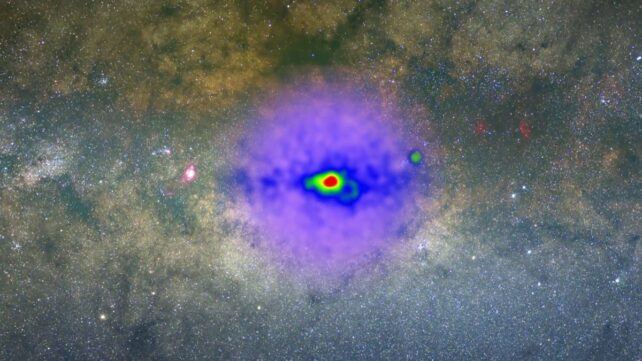A strange gamma-ray glow emanating from the heart of the Milky Way could be the long-sought fingerprint of dark matter particles annihilating each other, evidence suggests.
A new research effort involving simulations of Milky-Way-like galaxies shows that the mysterious, unexplained extra gamma radiation emanating from the region is equally likely to be due to dark matter annihilation as to millisecond pulsars – and the dark matter hypothesis might even have a slight edge.
"Dark matter dominates the Universe and holds galaxies together. It's extremely consequential and we're desperately thinking all the time of ideas as to how we could detect it," says astrophysicist Joseph Silk of Johns Hopkins University.
"Gamma rays, and specifically the excess light we're observing at the center of our galaxy, could be our first clue."
Related: Something's Glowing at The Galactic Core, And We Could Be Closer to Solving The Mystery

This gamma-ray glow, known as the Galactic Center GeV Excess (GCE), has puzzled astronomers since its discovery in 2009 in data from NASA's Fermi Gamma-ray Space Telescope. Something in the galactic center is producing a glow in the highest-energy form of light in the Universe, but whatever that something is, astronomers have yet to pin it down.
There are two leading candidates. One of those is dark matter, the mysterious source of extra gravity hanging around the Universe that can't be explained by the normal matter that makes up everything we can directly detect.
We don't know what dark matter is, but one hypothetical candidate is weakly interacting massive particles, or WIMPs. Scientists predict that when WIMPs and their antiparticles collide, they annihilate each other, exploding in a shower of different particles, including gamma-ray photons.
The other candidate is millisecond pulsars. These are neutron stars at the very end of their life cycle, formed from the collapsed core of a massive star that has ejected most of its material in a supernova explosion. What makes a neutron star a pulsar is its extremely rapid spin. As it spins, it emits beams of radio waves, particles, and radiation, including X-rays and gamma rays. As these beams sweep around, the pulsar appears to, well, pulse.
Astronomers have yet to detect the population of pulsars that could be responsible for the GCE, but there are ways to narrow down the possibilities. The population of old stars that should include pulsars in the galactic bulge – the central, bubble-shaped region of the Milky Way – seems to form an X-shape, while previous research suggests the Milky Way's dark matter halo is spherical.
These distributions would have different effects on the shape of the GCE. If the culprit is millisecond pulsars, the GCE should look boxy, while a dark matter origin would produce a more spherical shape. Depending on the interpretation, Fermi data suggest that the GCE has a distinctly boxy distribution.
Led by cosmologist Moorits Mihkel Muru of the Leibniz Institute for Astrophysics Potsdam in Germany, the researchers wanted to know if this box shape conclusively rules out dark matter annihilation from the list of GCE candidates.
They used supercomputers to run simulations of the evolutionary history of the Milky Way, mapping the density and distribution of the dark matter, and comparing it with the distribution of old stars used as a proxy for millisecond pulsars. Rather than modelling how annihilation increases over time, the team focused on the present-day dark-matter structure and its projected gamma-ray signal.
The results of these simulations were all observed from a distance of about 8 kiloparsecs – the distance of the Solar System from the Milky Way's center – so that they would appear as we would see them at our current observing position.
They found that the dark matter halo likely isn't perfectly round, but is slightly flattened as a result of the Milky Way's long history of mergers with other galaxies. When projected onto sky maps of the Milky Way, this produces a boxy gamma-ray glow from dark matter annihilation.
This suggests that a flattened shape is not necessarily diagnostic of millisecond pulsars, but equally could be the result of dark matter.

"Both hypotheses for the GCE, that of dark matter annihilations and millisecond pulsars, are equally plausible based on morphology, spectrum, and intensity, with perhaps a slight edge for the dark matter hypothesis on the last of these attributes in view of the observed deficiency in millisecond pulsars," the researchers write in their paper.
It's also important to note that some observations have revealed slightly uneven speckling in the GCE, as expected from point sources such as millisecond pulsars. Dark matter annihilation would produce a smoother glow. This new study doesn't directly address that small-scale texture, which has been explored in other analyses, but with the large-scale shape of the GCE no longer ruling out dark matter, it could be that both sources of the gamma radiation are active in the galactic center.
The authors note that upcoming observatories such as the Cherenkov Telescope Array and the Southern Wide-field Gamma-ray Observatory should help distinguish between the two scenarios.
"It's possible we will see the new data and confirm one theory over the other," Silk says. "Or maybe we'll find nothing, in which case it'll be an even greater mystery to resolve."
The research has been published in Physical Review Letters.

